CLOSE
inspiring you is my passion
REGGIO INSPIRED PRACTICE GUIDE
CONTACT VERONICA
LOOSE PARTS PLAY GUIDE
FREE RESOURCES
PROFESSIONAL TRAINING
FOR ECE'S
FOR TEAMS
from my perspective
this way to the blog!
TOOLKIT
Documentation
Templates
WORKSHOPS
CUSTOM TEAM BUNDLE
FREE TRAINING - POSSIBILITIES OF LOOSE PARTS
shop
CLOSE
inspiring you is my passion
EDUCATOR LIBRARY
CONTACT VERONICA
FREE LOOSE PARTS GUIDE
RESOURCES
PROFESSIONAL TRAINING
FOR ECE'S
FOR TEAMS
TOOLKIT
Documentation
Templates
WORKSHOPS
DIGITAL PD LIBRARY
LIVE WORKSHOPS
FULL DAY PD
FREE TRAINING - POSSIBILITIES OF LOOSE PARTS
New!!!
shop

inspiring & practical ideas
GET STARTED WITH
loose parts play
FREE DOWNLOAD
This guide is loaded with ideas, inventory lists, and resources to support you in conveying the learning that is happening while children play!
I only want creativity filling your inbox, so you'll see inspiration and support dropping in...but not too much!
We respect your privacy. Unsubscribe at any time.
When I first made Joshua his own sensory nook and quiet space in our dayhome, it was a LIFESAVER!!!
He finally had a space he felt safe and comfortable in and could relax and ease his body. I didn’t go out and spend tons of money on specialty items instead I did a little inspirational research on Pinterest, raided my craft supply and tapped into my out of the box creative mind.
I am going to share some of the ideas I came up with and resources that I have invested in to create all the sensory nooks we have had for our son.
SENSORY BOARDS
My first sensory board was a recycled piece of cardboard from a recent package and I traced a large circle with a lid from our pots, and hot glued a ton of Pom Poms onto the cardboard. It created a wonderful visual and textural sensory experience. That board has held up very well and is in his current sensory nook almost 3 years after I made it!
People have commented that their child would just rip them all off.
And I understand that, but for our son and his sensory needs he enjoyed touching and feeling all sorts of textures and so he didn’t rip them off!
That’s the thing about sensory needs, what works for one child may not work for the next. It is so individual.
I have created quite a few different sensory boards these last few years using a variety of items, such as jewel stickers, popsicle sticks, straws, colourful kitchen scrubbers, gel glitter stickers and velcro.
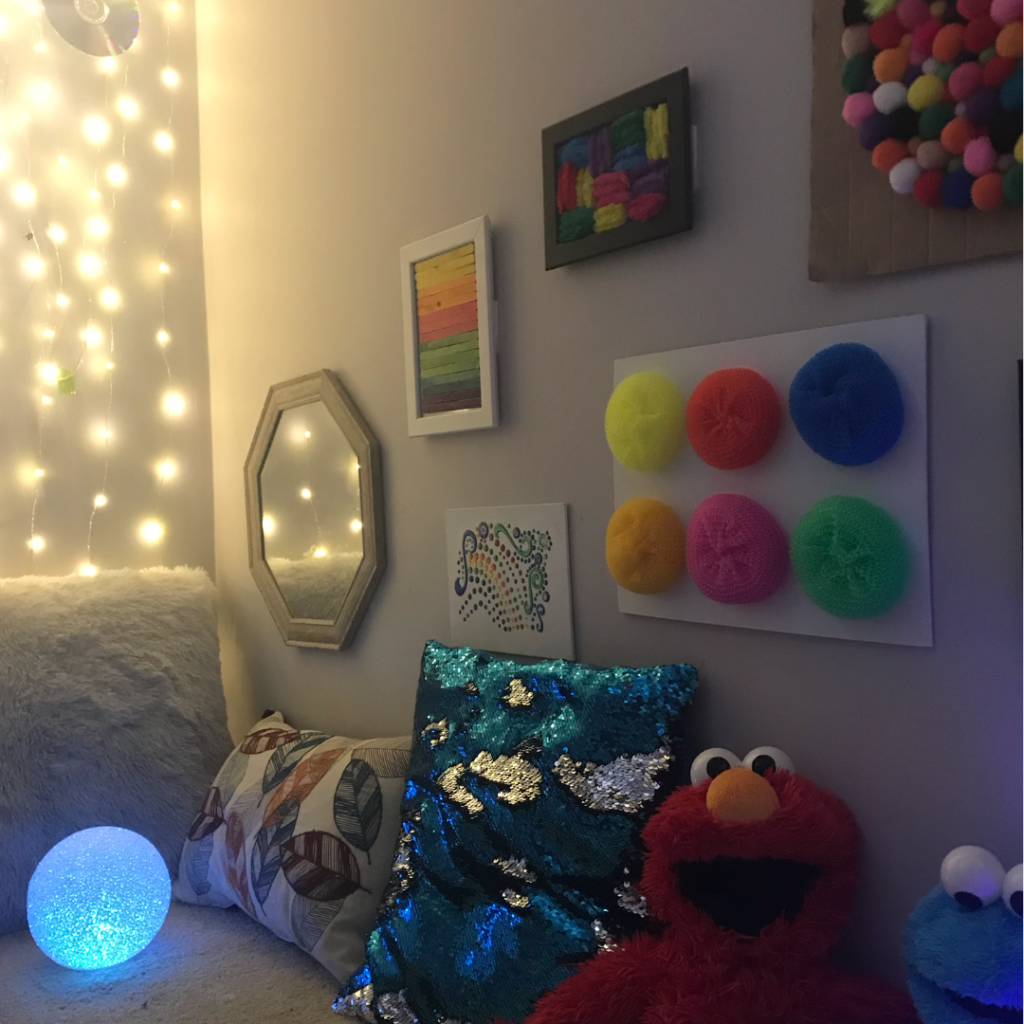

Throw Pillows
Other simple items I have incorporated are abstract art throw pillows that provide great visual stimulation but also proprioceptive input as well.
Throw pillows can have some good weight to them and Joshua loves for me to drop them onto his body or to to hit his joints in his legs with them as well.
We also have the mermaid sequence pillows that are also visual but of course textural as well! AND they provide fine motor skills, determination and problem solving skills to figure out how the change the sequence over.
For his new sensory nook I asked him to choose some new throw pillows, and he chose a wonderful soft and feathery grey pillow and also an embroidered leaf pillow with very calming colours. I LOVE that he chose such wonderful pillows that had great sensory input for him.
Throw pillows add so much coziness, make the space inviting and I find help draw Joshua into his sensory nook. Which is what we want!
I think one my greatest reuses was my pregnancy pillow in the bottom of his closet! It wrapped around the bottom perfectly and he loved curling up against it all the time.

Lights and Mirrors
Fairy lights are a wonderful addition to sensory nooks and quiet spaces. They provide a dim light that is easier on sensitive eyes, and just really make any space calmer.
Since Joshua is a visual seeker for good stimulation I’ve been able to find some pretty awesome light sources. Our light orbs from the dollar store have been one of my best finds! They are battery operated, the orb has a texture itself and it gives a little, allowing for him to squish it a little! So that’s visual, textural and proprioceptive sensory input all from a 3 dollar light orb!!!!
Other light sources are the fibre optic light, push lights and flashlights. We absolutely LOVE our LIGHT CUBE!! This resource has 16 different colours that can either rotate or have one solid light of your choice. This light cube has been an integral part of Joshua’s sensory diet.
Mirrors provide so much wonder and curiosity for children, and I find Joshua is captivated by them.
He loves to make faces in them, watch himself dance, and see the reflection of his actions while playing. We use real glass mirrors but I have also used acrylic mirrors from IKEA!
Another very economical resource that reflects light and provides visually stimulating colours is OLD DVDS. These are amazing! I have either raided our collection for old movies we don’t watch anymore or I have found many at reuse centres.
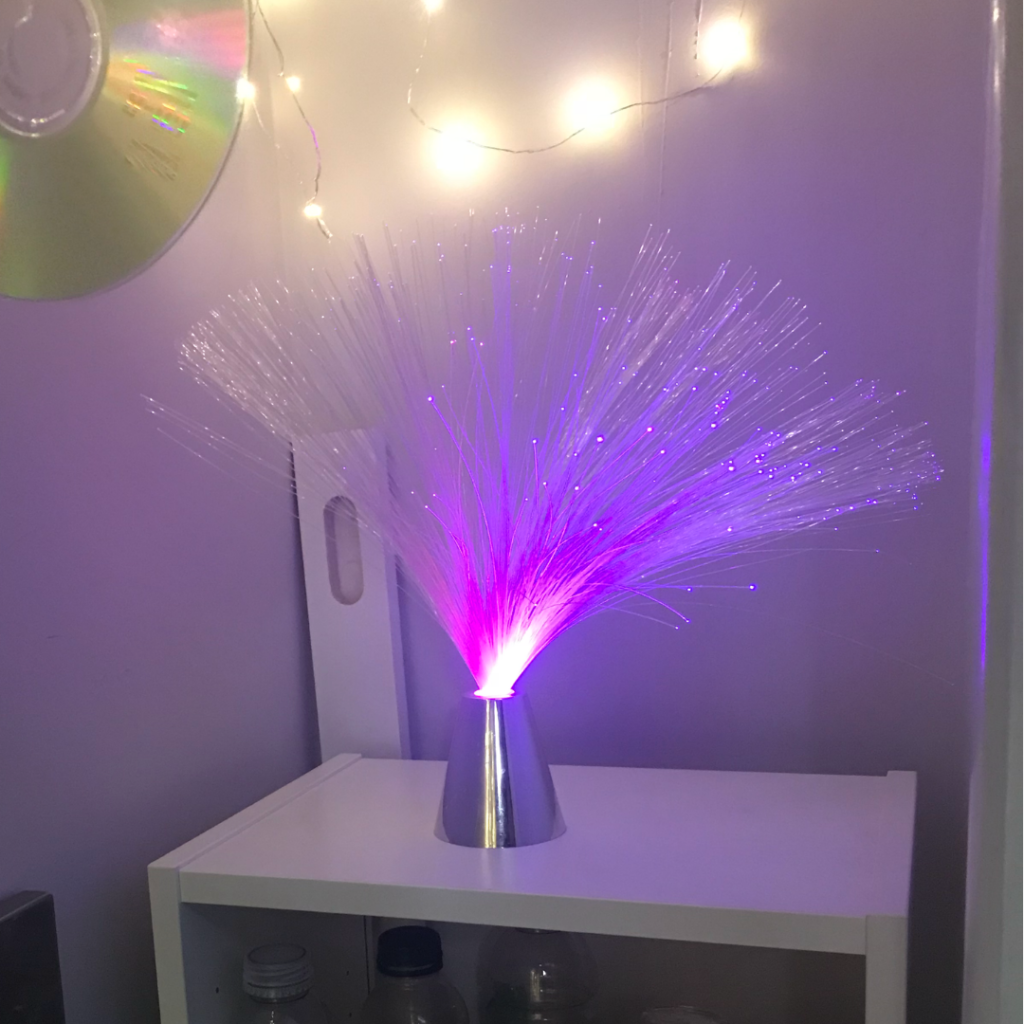
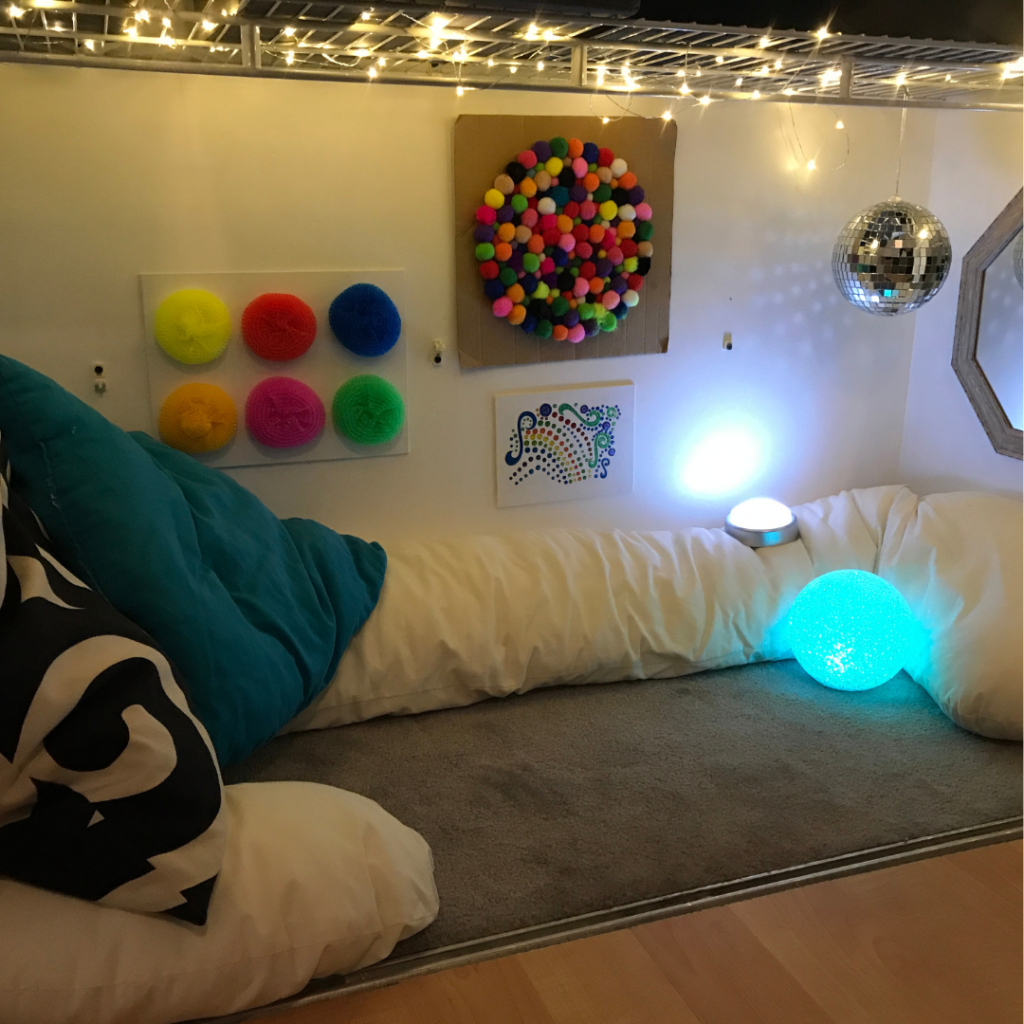
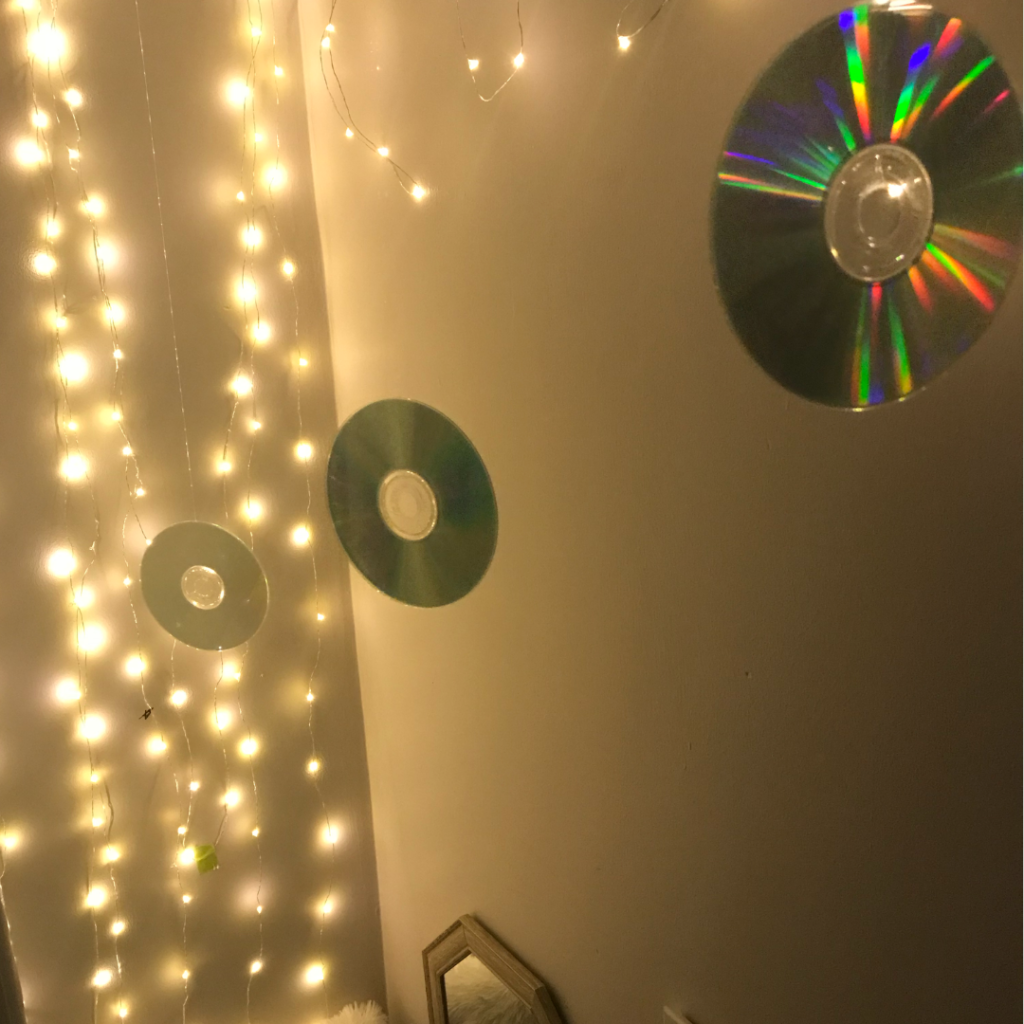
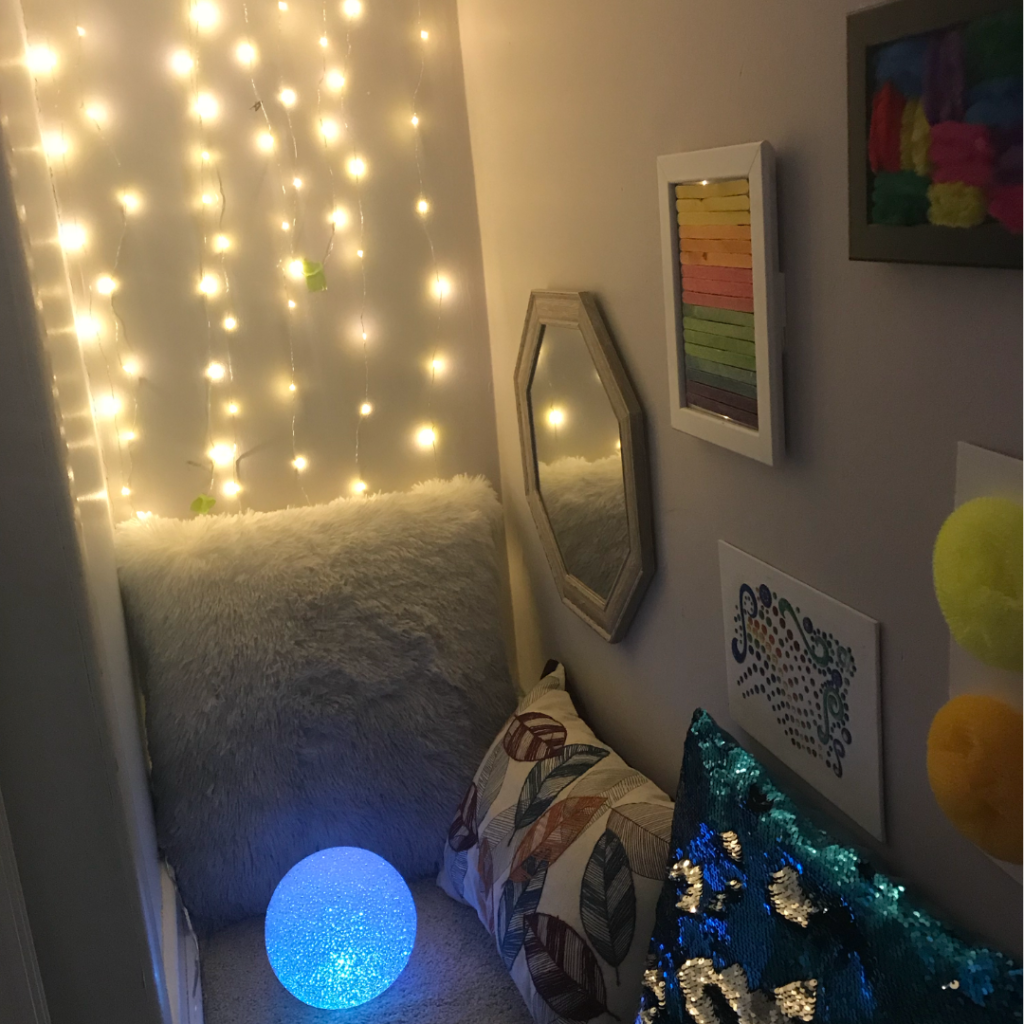

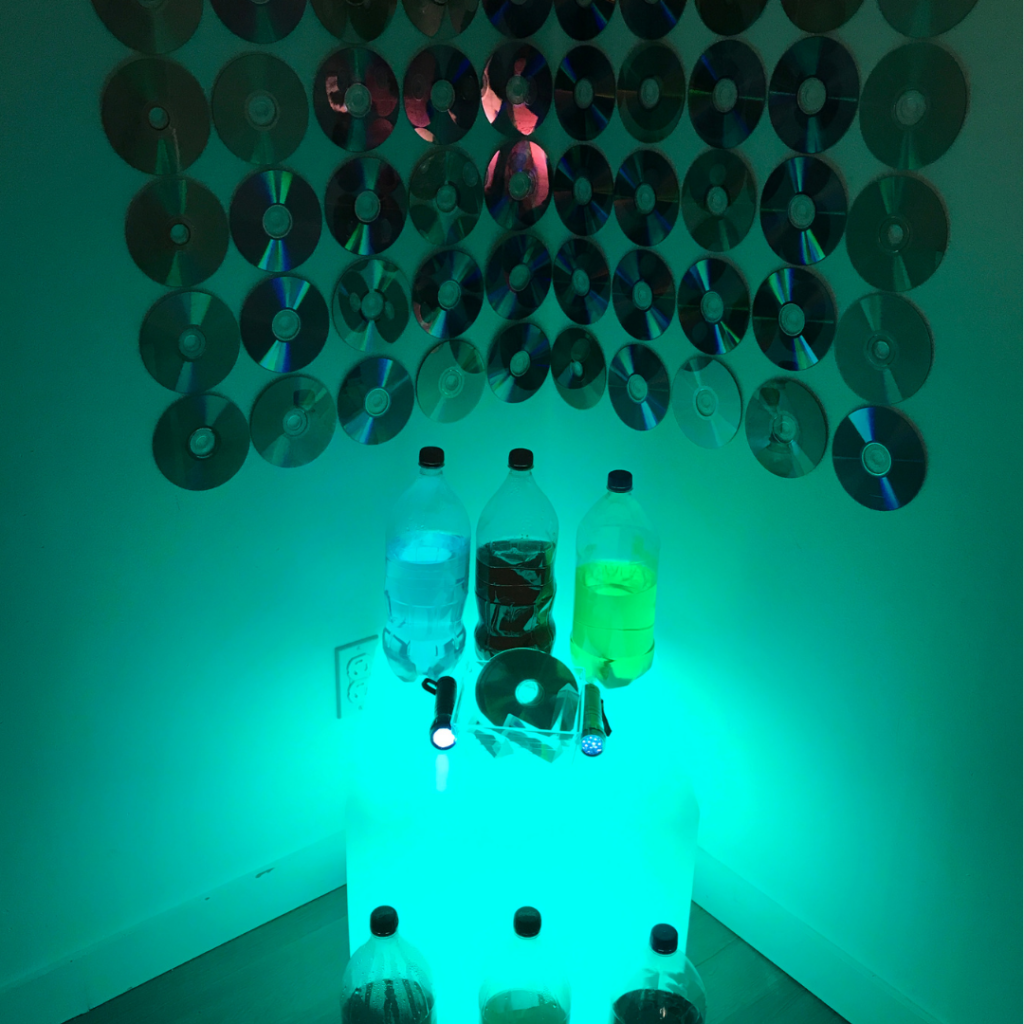
Sensory Bottles
Sensory bottles are so inexpensive, I like to use a variety of bottles because of their shape and textures they naturally provide.
I fill them with all sorts of different items such as,
- dried pasta
- vibrant Pom Poms
- rice
- water
- food colouring
- oil and food colouring
- beads
Basically anything you want!
All of these items provide great visual stimulation but also stimulate the auditory sense.
Here’s a special tip! Fill the bottle with different levels of water to provide different weights (this engages the proprioceptive sense!)
The common way these bottles are used is as a calm down tool. However I have yet to see them actually work that way, if I offered my son one of these bottles when he was upset he would throw it right back at me.
I find these resources as with many of them, they are best to have out all the time to provide the sensory input the child needs to help stay regulated throughout the day.

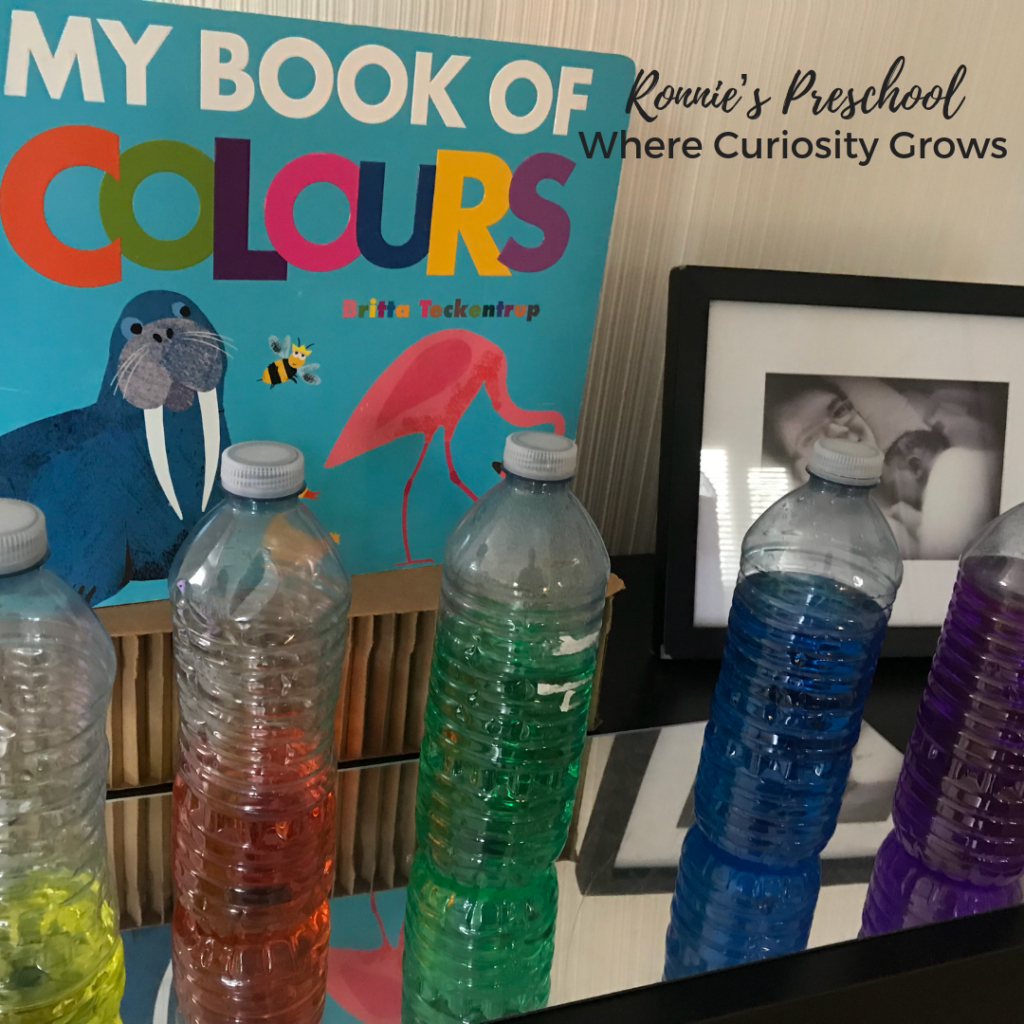
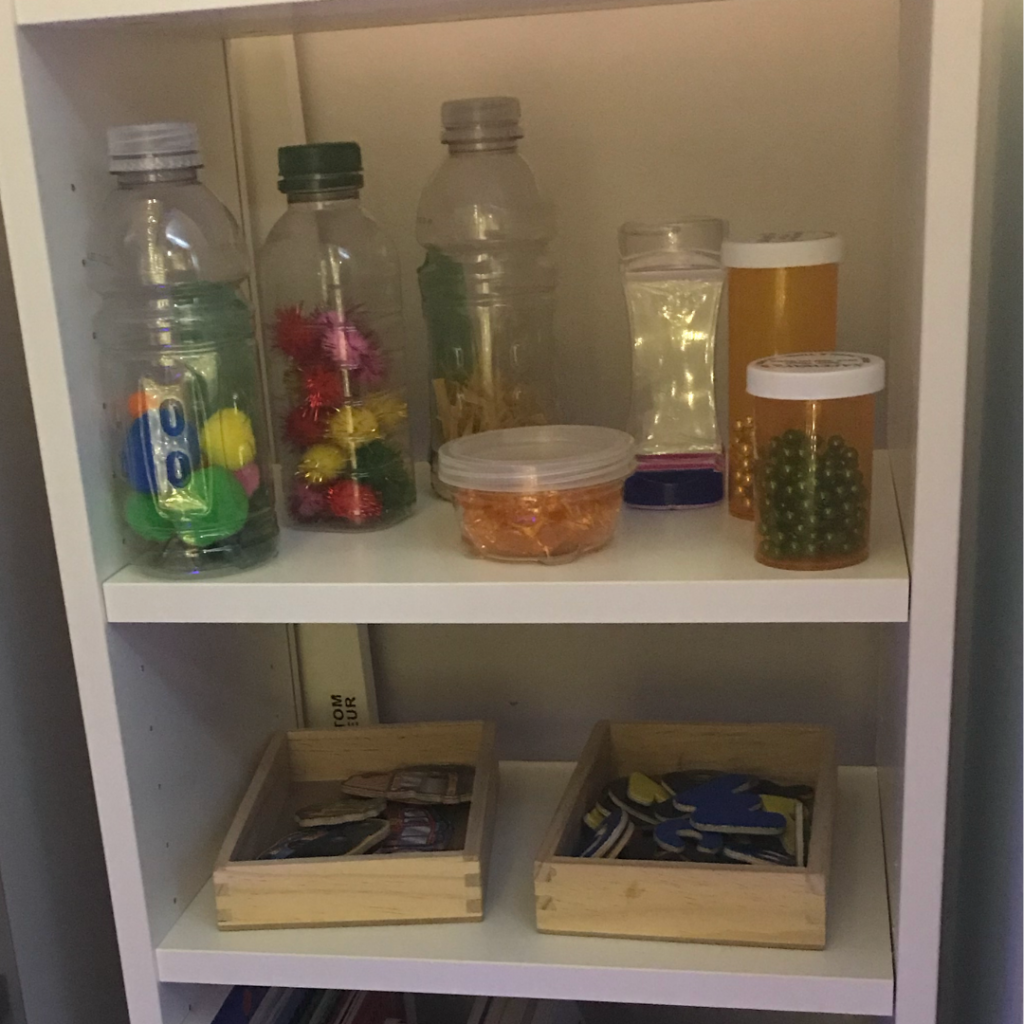
Sensory Nook Areas
Imagine always being in flight or fight mode, not feeling safe, people not understanding you, your anxiety is through the roof and you’re exhausted from crying all the time.
Our sensory kids feel like this all the time, well I know Joshua did for a very long time.
When we began to look past his behaviours and tried to understand what he was really telling us, we began to “hear” him say how much he needed to feel safe and the world was too much for him.
Sensory nooks and quiet spaces provide a safe place where the child is understood and they are able to begin to communicate their needs in ways that are more visible to the rest of us.
For our son we had sensory nooks for him on all levels of our home, and I utilized the bottom of his closet in his room for one!
Was a great little quiet space that only he could fit into, and this sensory nook was a big help with the really big meltdowns to help him regulate again.
Once he was calm, he would engage with the items and we would either give him space to play or interact with him if he allowed.
When creating sensory nooks and quiet spaces, consider setting it up in spaces that are quiet and low traffic areas.
The play spaces that we have for him in the living room also have sensory items for him, so that he has access all day long.
Utilize Unique Areas for Sensory Nooks
In our new home, I again utilized his entire closet to recreate his sensory nook after we moved, and I was able to create a beautiful space with the items we currently had and only bought the two additional throw pillows that he picked out.
When I first started creating these sensory nooks and quiet spaces, I used painters tape to adhere the sensory board and acrylic mirrors to the walls, of course they would fall down every now and then.
His latest sensory and play spaces I have invested in 3M command strips and they are securing all the sensory boards, mirrors, pictures, and any other items I have up very well.


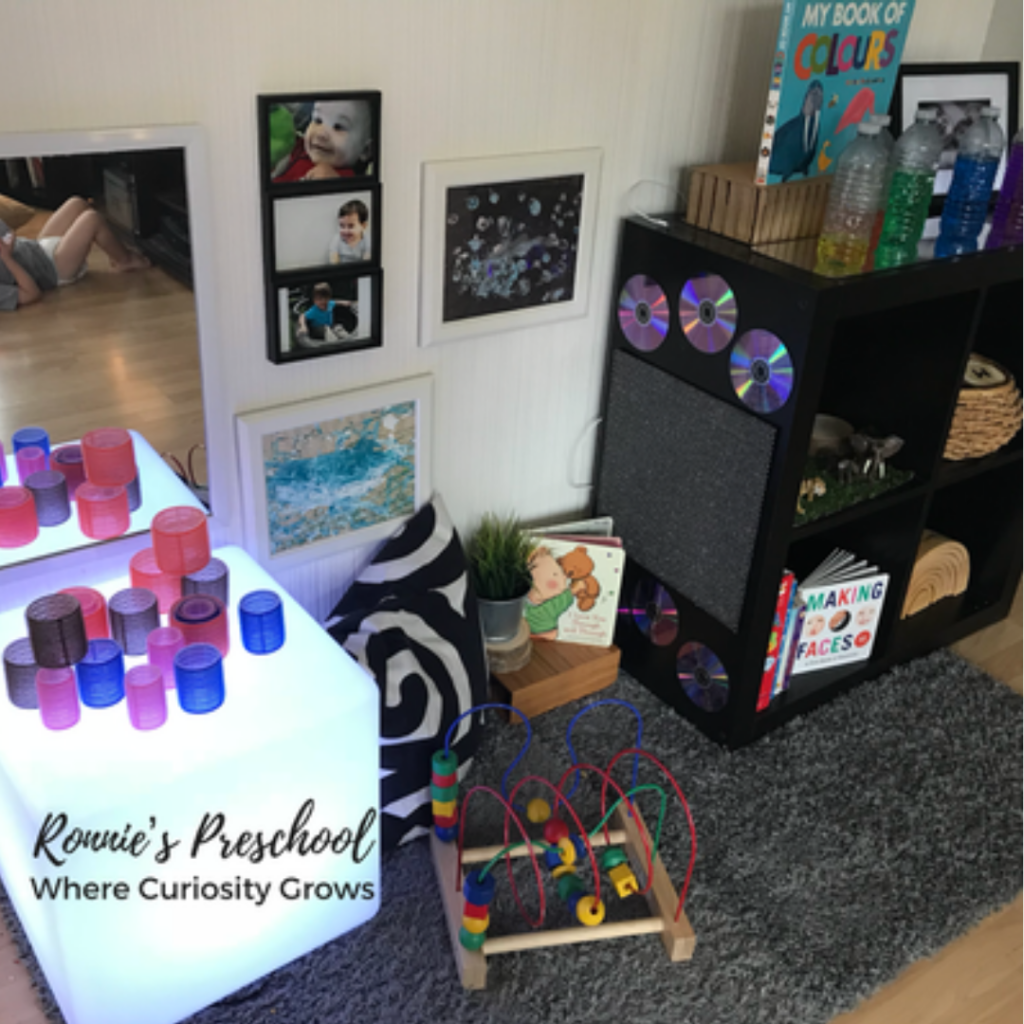
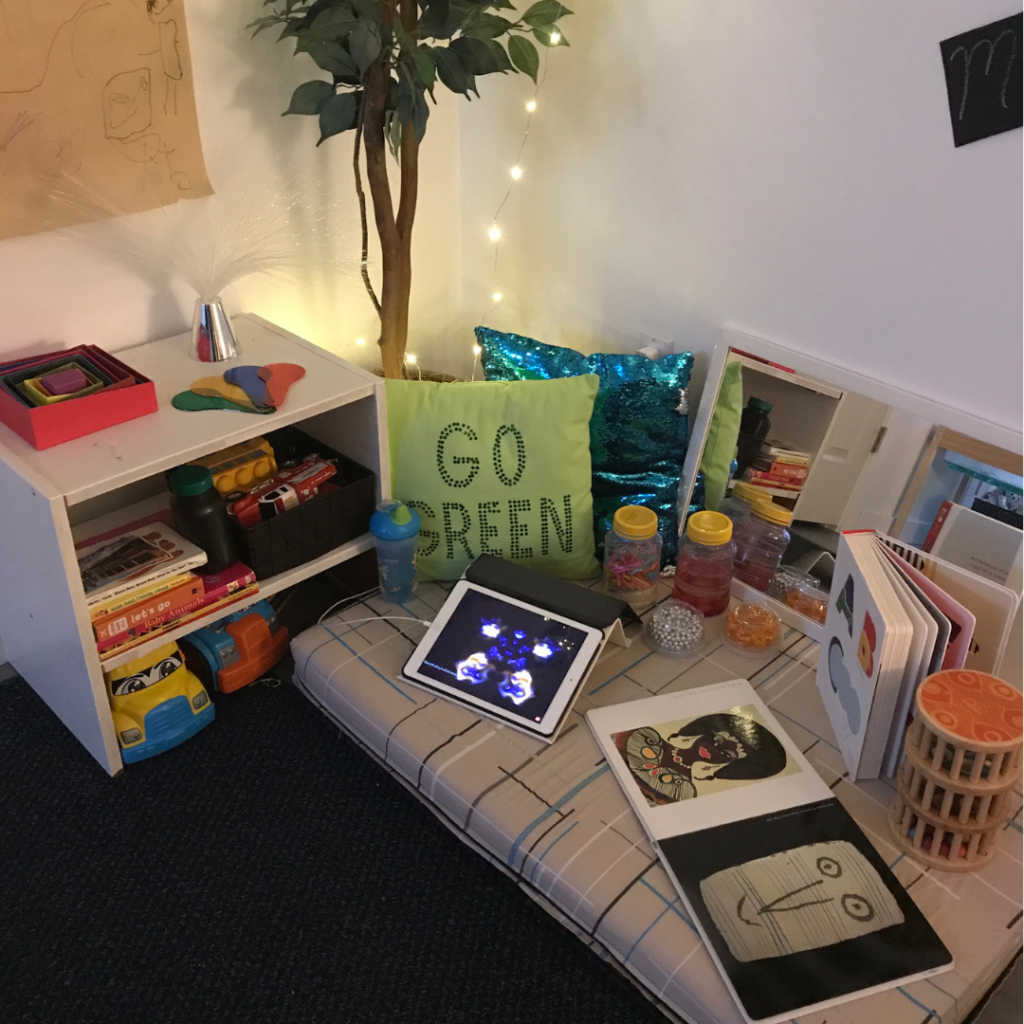

Individual Needs
The most important thing to remember is to make sure that you keep your child’s sensory needs in mind.
We have focused a lot on texture and visual because that is what Joshua’s needs are and these resources work.
What I hope is that you are inspired and feel that creating these necessary spaces for our children is very possible.
Make sure to grab the FREE guide 👉 The Behaviour Decoder Guide
(You’ll find it helps you start observing behaviour through new eyes.)
If going further into sensory processing and understanding how this can help support children and ease behaviours in your program, I encourage you to learn more about my online workshop Supporting Sensory Needs – Understanding What Behaviours Are Communicating. This is hosted LIVE online and can learn more about it here.
I’ll walk you through all 8 senses and provide many examples of behaviours, what the children might be communicating and how to make simple and easy accommodations in your early learning environments.
Hey there!
I'M VERONICA
I am an Early Childhood Consultant and very passionate about supporting and inspiring my fellow Educators. I will share my reflections and experiences about implementing my philosophy, views, and ideas into my practice.
COFFEE & BOOK LOVER
find more on
stay connected
Sensory Nooks & Quiet Spaces
Leave a Reply Cancel reply
ENDLESS POSSIBILITIES OF
loose parts play
ON-DEMAND FREE TRAINING
Unlock the possibilities to simplify your planning, become proactive with behaviours & enjoy your role again! I'll guide you to find the beauty in loose parts play.
DISCOVER THE POSSIBILITIES!
I'M VERONICA.
EARLY YEARS CONSULTANT
Here to help you simplify planning, understand behaviours & build strong relationships...all with the magic of loose parts!
ENGAGE YOUR CURIOSITY
MY EARLY YEARS JOURNEY
THE MODERN EDUCATOR TOOLKIT
WORKSHOP (LIVE & REPLAYS)
CUSTOM TEAM PD BUNDLE
POSSIBILITIES OF LOOSE PARTS TRAINING
CONTACT
get your
guide!
Wanna know how to GET STARTED with these magical materials?
find out right here!
back to top
WEEKLY EMAIL
join the
let's stay connected...
Only inspiration & support will drop in your inbox. Unsubscribe at anytime.
CLOSE
I'M VERONICA.
Here to help you simplify planning, understand behaviours & build strong relationships...with the magic of loose parts!
VERONICA
POSTED BY:
also known as Ronnie!
SPECIAL NEEDS MOMMA &
EARLY CHILDHOOD CONSULTANT
Inspiring and mentoring my fellow educators how to use loose parts to enhance all aspects of their practice. I share my dual roles of educator & momma and how our autistic son has shown me so many new perspectives.
read about my early years journey